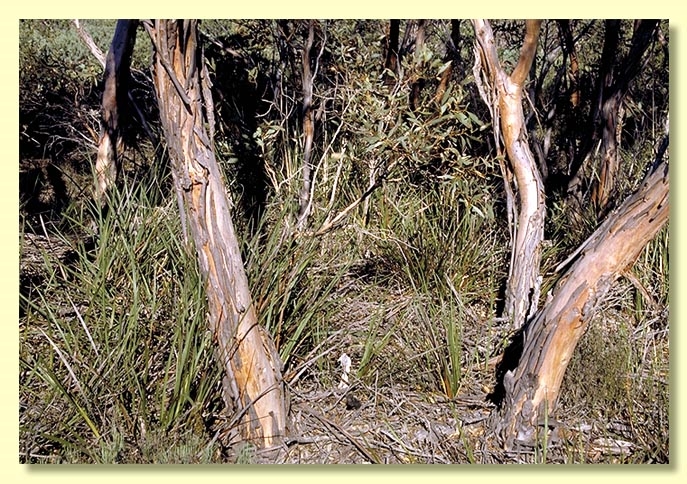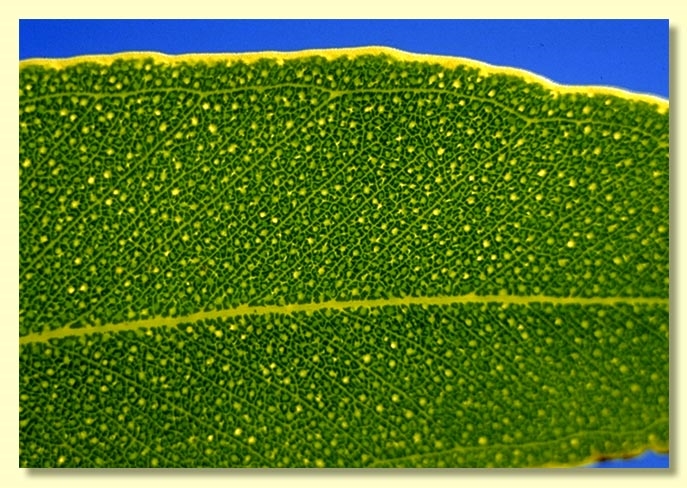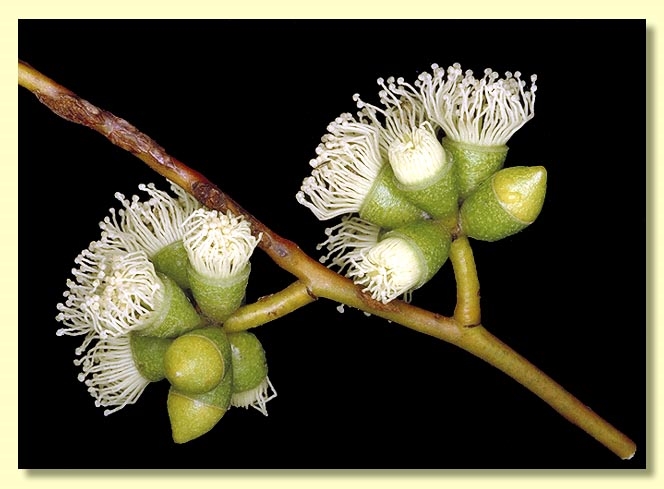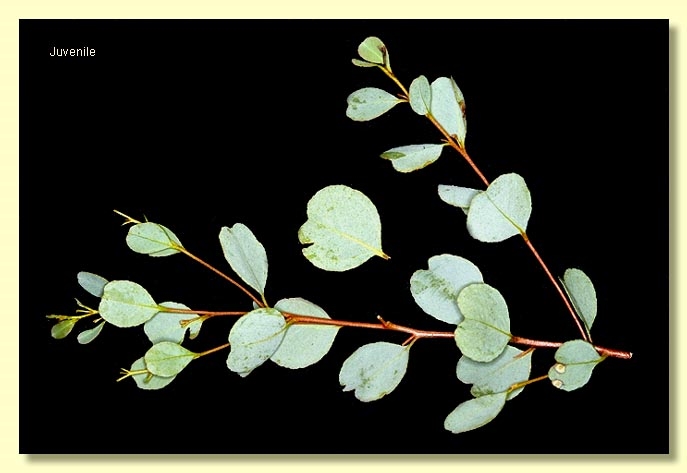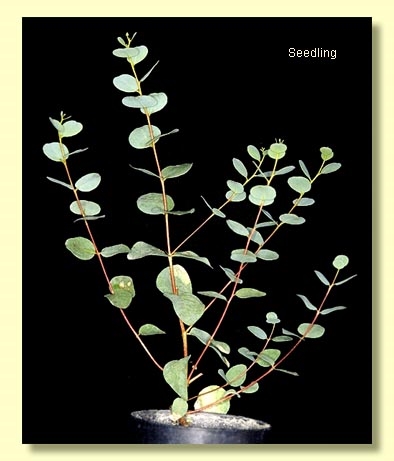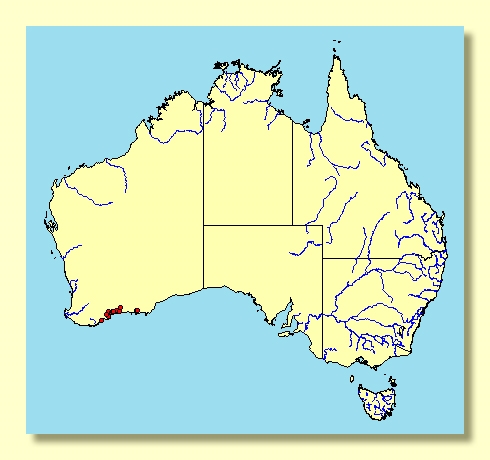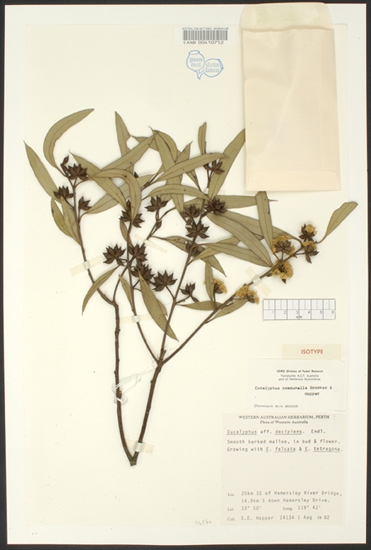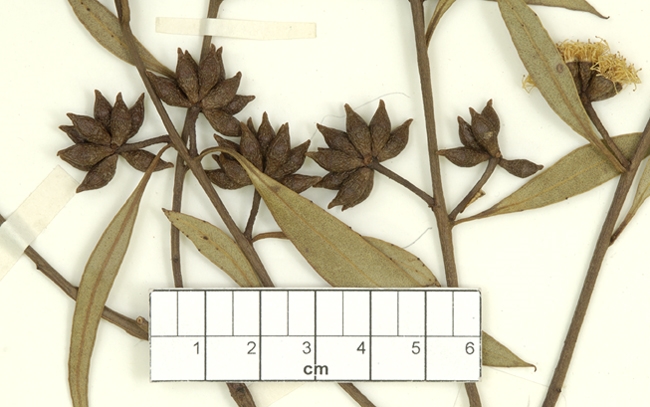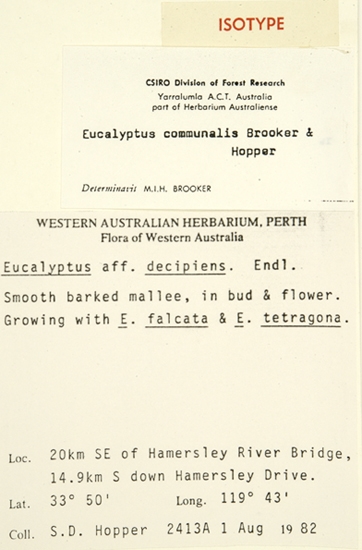Eucalyptus | Symphyomyrtus | Bisectae | Destitutae | Falcatae | Decipientes
Euclid - Online edition
Eucalyptus communalis
Bark smooth throughout, shedding in short ribbons, pale grey and pinkish grey over coppery to white.
Branchlets lacking oil glands in the pith.
Juvenile growth (coppice or wild seedling to 50 cm tall): stems rounded in cross-section; juvenile leaves very shortly petiolate, sub-opposite to alternate, orbicular (may be wider than long) to obcordate, 1.5–3 cm long, 1.5–3 cm wide, base tapering, margin subcrenulate to entire, apex usually emarginate.
Adult leaves alternate, petioles 0.5–1.7 cm long; blade lanceolate, 5–8.5 cm long, 1–1.8 cm wide, base tapering to petiole, margin entire, apex pointed, side-veins at an acute or wider angle to midrib, reticulation dense, intramarginal vein remote from margin, oil glands numerous, irregular, intersectional.
Inflorescence axillary unbranched, peduncles 0.5–1.5 cm long, buds ?11 to more than 15 per umbel, sessile to shortly pedicellate (pedicels 0–0.3 cm long). Mature buds squatly ovoid to fusiform (0.8–0.9 cm long, 0.4–0.45 cm wide), scar present, operculum conical to beaked, stamens inflexed, anthers reniform, versatile, dorsifixed, dehiscing by short lateral slits, style long and straight, stigma blunt to slightly rounded, locules 3(4), the placentae each with 4 vertical rows of ovules. Flowers creamy white.
Fruit sessile or shortly pedicellate (pedicels 0–0.2 cm long), flattened and truncate-globose, crowded, 0.5–0.6 cm long, 0.6–1 cm wide, disc level, valves 3(4), at rim level or the fragile tips exserted.
Seeds grey-brown, 1.5–2.5 mm long, ovoid or flattened-ovoid, dorsal surface smooth, hilum ventral.
Cultivated seedlings (measured at ca node 10): cotyledons Y-shaped (bisected); stems rounded in cross-section, smooth or slightly warty; leaves very shortly petiolate, opposite for ca 7 to 9 nodes then alternate, more or less orbicular to obcordate (often wider than long), 1–3 cm long, 1–3 cm wide, base tapering or rounded, margin subcrenulate to entire, apex markedly emarginate, dull, grey-green.
Flowering has been recorded in January and August.
A mallee endemic to Western Australia, and, as originally described, found in southern coastal heathlands from south of Jerramungup and Ravensthorpe east to the Cheadanup Reserve and to Coolinup which is east of Esperance. It is most easily found on the eastern plains of the Fitzgerald River National Park where it occurs in small isolated stands emergent above the extensive sclerophyllous heath of the plain. The bark is smooth, the juvenile leaves emarginate and the adult leaves glossy green.
In the classificaton of Brooker (2000) Eucalyptus communalis belongs in Eucalyptus subgenus Symphyomyrtus section Bisectae subsection Destitutae because buds have two opercula, cotyledons are Y-shaped and branchlets lack oil glands in the pith. Within this sub-subsection E. communalis belongs to a distinctive small group all with shortly stalked or sessile buds in crowded stellate clusters in the leaf axils, crowded fruit and with adult leaves having numerous side-veins, dense reticulation and intersectional oil glands. In this small group (known as series Falcatae subseries Decipientes) there are five species, viz. E. decipiens, E. communalis, E. obesa, E. balanites and E. phylacis, but see note below.
In the juvenile leaf characters and the ovoid to fusiform buds E. communalis is closest to E. decipiens, which differs in being a taller mallee and at least partly rough-barked. The other species in subseries Decipientes, smooth-barked E. obesa, and rough-barked E. balanites and E. phylacis, have ovoid or diamond-shaped buds.
Nicolle & French, Nuytsia 22: 451 (2012), argue that this taxon is simply a few individuals morphologically intermediate between the more abundant coastal and subcoastal mallees E. adesmophloia and E. obesa, both of which occur in the genaral area. These authors also argue that the other known stands referred to by Brooker and Hopper are either E. obesa or E. adesmophloia , and not morphological intergrades.


